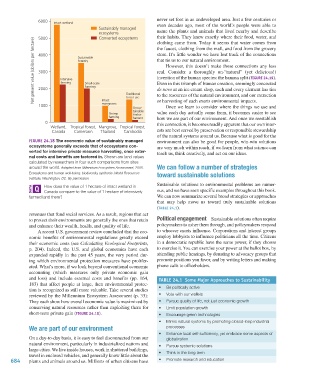Page 685 - Environment: The Science Behind the Stories
P. 685
never set foot in an undeveloped area. Just a few centuries or
6000 Intact wetland even decades ago, most of the world’s people were able to
Sustainably managed name the plants and animals that lived nearby and describe
ecosystems their habits. They knew exactly where their food, water, and
Converted ecosystems
5000
Net present value (dollars per hectare) 4000 Intensive Sustainable store. It’s little wonder we have lost track of the connections
clothing came from. Today it seems that water comes from
the faucet, clothing from the mall, and food from the grocery
that tie us to our natural environment.
forestry
However, this doesn’t make those connections any less
real. Consider a thoroughly un-“natural” (yet delicious!)
3000
invention of the human species: the banana split (Figure 24.19).
Even in this triumph of human creation, seemingly concocted
farming
Small-scale
farming
2000
to the resources of the natural environment, and our extraction
forest use
or harvesting of each exerts environmental impacts.
mangroves
1000 Intact Traditional de novo at an ice cream shop, each and every element has ties
Once we learn to consider where the things we use and
Unsus-
tainable value each day actually come from, it becomes easier to see
Shrimp timber
farming harvest how we are part of our environment. And once we reestablish
0 this connection, it becomes readily apparent that our own inter-
Wetland, Tropical forest, Mangrove, Tropical forest,
Canada Cameroon Thailand Cambodia ests are best served by preservation or responsible stewardship
of the natural systems around us. Because what is good for the
Figure 24.18 The economic value of sustainably managed environment can also be good for people, win-win solutions
ecosystems generally exceeds that of ecosystems con- are very much within reach, if we learn from what science can
verted for intensive private resource harvesting, once exter- teach us, think creatively, and act on our ideas.
nal costs and benefits are factored in. Shown are land values
calculated by researchers in four such comparisons from sites
around the world. Adapted from Millennium Ecosystem Assessment, 2005. We can follow a number of strategies
Ecosystems and human well-being: biodiversity synthesis. World Resources toward sustainable solutions
Institute, Washington, DC. By permission.
How does the value of 1 hectare of intact wetland in Sustainable solutions to environmental problems are numer-
Canada compare to the value of 1 hectare of intensively ous, and we have seen specific examples throughout this book.
farmed land there? We can now summarize several broad strategies or approaches
that may help move us toward truly sustainable solutions
(Table 24.1).
revenues that fund social services. As a result, regions that act
to protect their environments are generally the ones that retain Political engagement Sustainable solutions often require
and enhance their wealth, health, and quality of life. policymakers to usher them through, and policymakers respond
A recent U.S. government review concluded that the eco- to whoever exerts influence. Corporations and interest groups
nomic benefits of environmental regulations greatly exceed employ lobbyists to influence politicians all the time. Citizens
their economic costs (see Calculating Ecological Footprints, in a democratic republic have the same power, if they choose
p. 204). Indeed, the U.S. and global economies have each to exercise it. You can exercise your power at the ballot box, by
expanded rapidly in the past 45 years, the very period dur- attending public hearings, by donating to advocacy groups that
ing which environmental protection measures have prolifer- promote positions you favor, and by writing letters and making
ated. What’s more, if we look beyond conventional economic phone calls to officeholders.
accounting (which measures only private economic gain
and loss) and include external costs and benefits (pp. 164, Table 24.1 Some Major approaches to Sustainability
183) that affect people at large, then environmental protec-
tion is recognized as still more valuable. Take several studies • Be politically active
reviewed by the Millennium Ecosystem Assessment (p. 33): • Vote with our wallets
They each show how overall economic value is maximized by • Pursue quality of life, not just economic growth
conserving natural resources rather than exploiting them for • Limit population growth
short-term private gain (Figure 24.18). • Encourage green technologies
• Mimic natural systems by promoting closed-loop industrial
We are part of our environment processes
• Enhance local self-sufficiency, yet embrace some aspects of
On a day-to-day basis, it is easy to feel disconnected from our globalization
natural environment, particularly in industrialized nations and • Pursue systemic solutions
large cities. We live inside houses, work in shuttered buildings,
travel in enclosed vehicles, and generally know little about the • Think in the long term
684 plants and animals around us. Millions of urban citizens have • Promote research and education
M24_WITH7428_05_SE_C24.indd 684 13/12/14 10:40 AM

